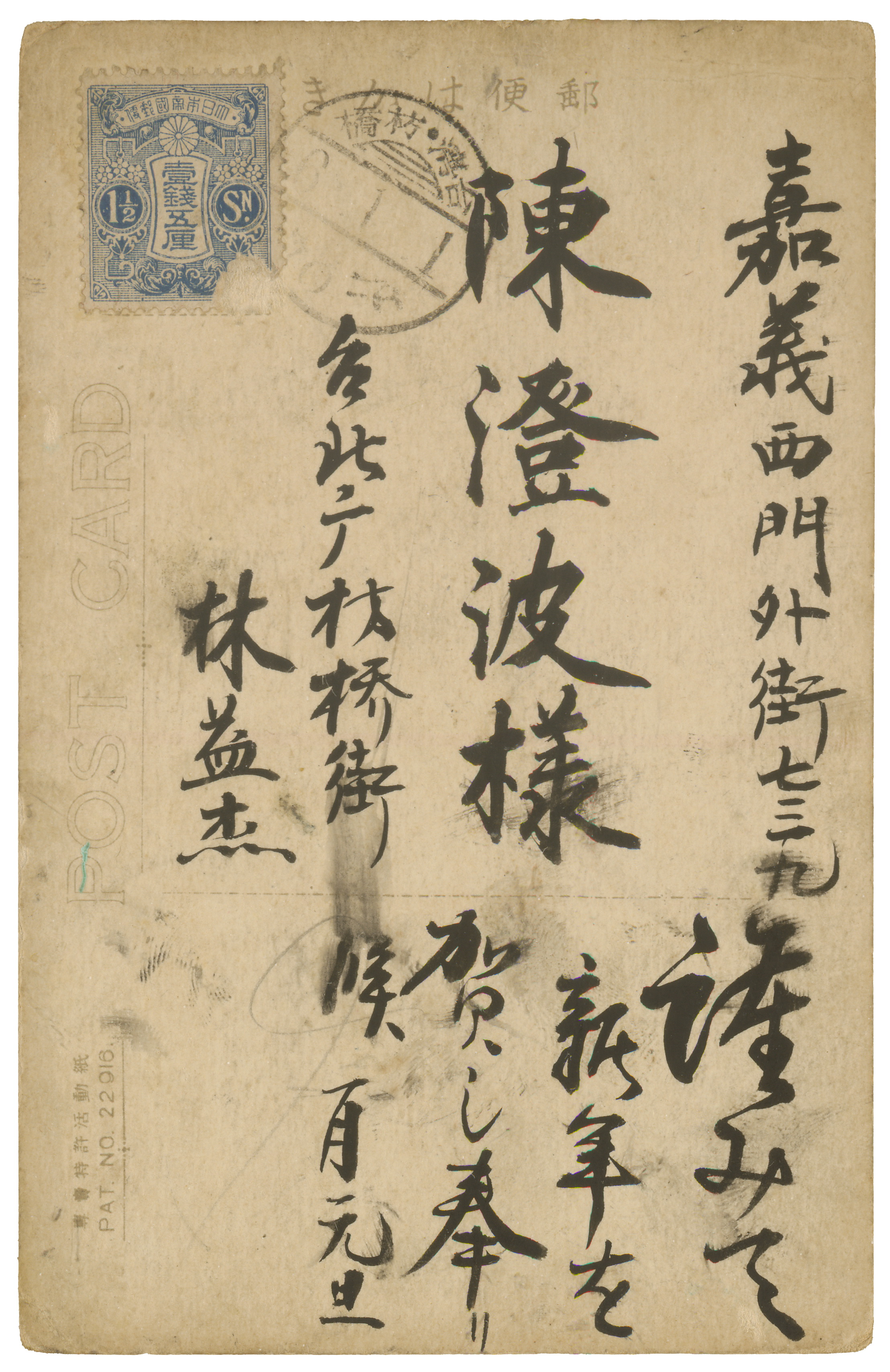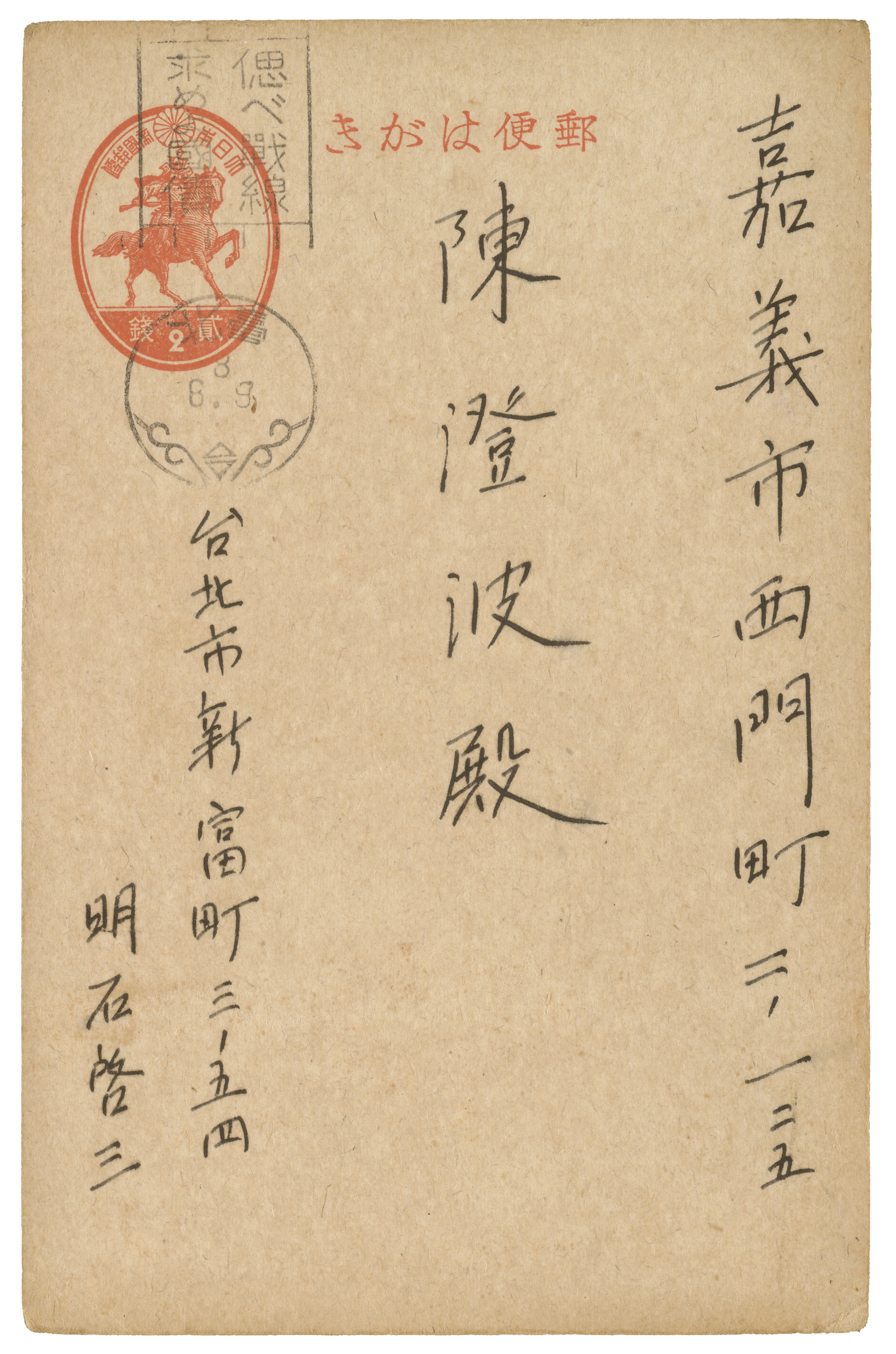嘉義街外(三)
為提供使用者有文書軟體選擇的權利,本文件為ODF開放文件格式,建議您安裝免費開源軟體 ([連結])
.jpg)
嘉義街外(三)
Outside Chiayi Street (3)
嘉義の町はづれ(3)
1927, 畫布油彩, 52×65cm
oil on canvas
画布油彩
溝渠接連著道路,廟簷上的翹脊在街邊勾成醒目的弧形,展開在陳澄波眼前的風景,就是他曾經透過繪畫介紹到日本的故鄉樣貌。相較於早前那件獲選帝展的傑作,在這幅畫裡,現代化的作用力,似乎更進一步地形塑了秩序的齊整。遙望著遠方的嘉義市街,陳澄波再次完成了一件相仿的風景畫,或許也是為這座城市的轉變,留下某種紀錄。
A shallow irrigation canal leads to a street, farther along and at the edge of which the upturned arc of a temple roof punctuates the sky. A year prior to the completion of this painting, Chen Cheng-po’s masterpiece depicting the same scene was selected for the Imperial Exhibition and introduced his hometown to Japanese art aficionados. In comparison with the earlier work, this painting reflects the influence of modernization, the landscape visibly more neat and orderly. Perhaps gazing at the streets of Chiayi from a distance, Chen chose once more to paint this scene in order to leave a record of the transformations underway in his beloved city.
道路へと続く水路、道端で目を引く廟の燕尾脊。眼前に広がるのは、陳澄波がかつて絵画作品を通して日本に紹介した故郷の情景です。この作品より前に帝展入選を果たした傑作に比べると、この絵では近代化が更に進んで、整然とした秩序が形作られているように見えます。遠くに嘉義市街地を眺めやりながら、再び似たような風景画を完成させた陳澄波は、この町の変化を記録として描き留めたかったのかもしれません。
.jpg)
1.四幅《嘉義街外》
Outside Chiayi Street: the four paintings
4枚の『嘉義の町はづれ』
這幅畫的取景與1926年陳澄波初次入選帝展的作品雷同,只有視點稍微向後移動。目前所知,陳澄波至少有四件作品都描繪了同樣一條街道,其作畫視角也都相仿。如此的反覆描繪,說明了這條街上的風景在畫家心中的特殊意義。
The vista pictured in this painting is strikingly similar to that in Chen’s 1926 work of the same name, his first to be selected for the Imperial Exhibition. The only apparent difference is a slight shift backwards in vantage point. At present, there are four known works by Chen which depict this same streetscape and all are painted from roughly the same perspective. Appearing over and over in his works, this scene must have held special sentimental significance for the painter.
この作品を描いた場所は1926年に帝展初入選を果たした作品と同じですが、視点が少しばかり後ろに移動しています。今のところ、同じ視点・同じ道の風景を陳澄波は少なくとも4枚描いていることがわかっています。何度も繰り返し描いたのは、画家にとってこの道の風景が、何か特別な意味を持っていたからでしょう。
-1.jpg)
.jpg)
左:嘉義街外(一),1926,畫布油彩,40號。
中:嘉義街外(二),1927,畫布油彩,65×53.4cm。
右:嘉義街外(四),1928,畫布油彩,15.7×22.7cm。
Left: Outside Chiayi Street (1), 1926, oil on canvas, #40
Middle: Outside Chiayi Street (2), 1927, oil on canvas, 65 x 53.4 cm
Right: Outside Chiayi Street (4), 1928, oil on canvas, 15.7 x 22.7 cm
左:嘉義の町はづれ(1),1926,画布油彩,40号
中:嘉義の町はづれ(2),1927,画布油彩,65×53.4cm
右:嘉義の町はづれ(3),1928,画布油彩,15.7×22.7cm
2.市街與原野的交界
At the juncture of city and countryside
市街地と原野の境目
筆直的道路、溝渠與電線桿,說明了畫中街道已是經過現代化整備的都市空間。但在1920年代末期,這幅畫的取景地點,正好位於都市擴張範圍的邊緣地帶。而陳澄波所欲表現的畫作主題,或許也就是自然與文明交界點上的風景。
The perfectly straight roadway, irrigation canal, and electric poles—all suggest that this lane has been modernized and transformed into the urban space. Yet, during the late 1920s, this area was still well within the outwardly expanding periphery of the city. Perhaps the intended motif of this painting was just that—a landscape situated at the boundary between nature and civilization.
真っ直ぐに伸びる道と水路、電柱を見れば、この道が近代的に整備された都市空間の一部であることがわかります。しかし、1920年代末期、この絵を描いた場所は拡張されていく町の周辺地域、町外れに位置していました。陳澄波が表現しようとした主題も、自然と文明が交わる境界線上にある風景だったのかもしれません。
3.道路風景畫
Streetscape painting
道路の風景画
以道路為主體作單點透視的構圖,在明治時代的日本畫壇便已蔚為流行,陳澄波的繪畫啟蒙老師石川欽一郎也擅於使用這樣的手法。以街道作為軸線,能帶領觀眾的視線向畫面深處行進,並協助畫家沿途鋪陳該地方的特色風景。
During the Meiji era, one-point perspective compositions featuring roadways as principal subjects came into vogue among Japanese art circles. In fact, Ishikawa Kinichiro, the instructor who first sparked Chen’s interest in painting, was adept at using this technique. Positioning a roadway along a painting’s central axis provides the painter with a convenient path along which to depict the unique features of the local landscape and to guide the viewer’s gaze into the painting.
明治時代の日本画壇では、道路を主体とした一点透視の構図が大いに流行しました。陳澄波が啓蒙された絵画の師・石川欽一郎もこのような手法を巧みに用いていました。道を軸線として観る者の視線を画面の奥へと導き、その助けとして道沿いにその場所の特色ある風景が描かれています。
4.陳澄波故居
Chen Cheng-po’s residences in Chiayi
陳澄波旧居
媽祖廟的後方不遠處,就是位於「西門町2丁目125番地」的陳澄波故居。但創作這幅畫的時候,他的老家仍在鄰近的「西門外街739番地」。觀察陳澄波所遺留的書信,也可以發現他的收件地址在1933年之後,因為搬家而有了改變。
When Chen painted this work, he was living nearby at Plot 739, Ximen Outer Street. However, as indicated by letters discovered among his personal belongings, he changed residences in 1933 and began using a different mailing address. His later home was located not far behind the Temple of the Wenling Sea Goddess, at Plot 125, District 2, Ximen Ward.
媽祖廟の裏手からそれほど遠くない「西門町2丁目125番地」に陳澄波の旧居があります。しかし、この絵を描いた頃、陳澄波の自宅はすぐ近くの「西門外街739番地」にありました。陳澄波が残したハガキを見ると、1933年以降、転居のために宛先が変わっています。


1933年6月,陳澄波在嘉義的收件地址,已經與1931年1月所收到的賀年卡截然不同。
These postcards document a change in Chen’s mailing address. The address on the postcard dated June 1933 is different from that on the New Year’s card dated January 1931.
1933年6月、陳澄波宛のハガキに記された嘉義の住所は、1931年1月に届いた年賀状の宛先とは異なっている。
圖左:LE2_021,1931.1.1林益杰致陳澄波之明信片。
圖右:LE2_030,1933.6.9明石啟三致陳澄波之明信片。
Photo (left): LE2_021, 1931.1.1, a postcard Chen received from Lin Yi-jie.
Photo (right): LE2_030, 1933.6.9, a postcard Chen received from Akashi Keizo.
左:LE2_021,1931.1.1林益杰が陳澄波に送ったハガ。
右:LE2_030,1933.6.9明石啓三が陳澄波に送ったハガキ。
5. 溫陵媽祖廟
The Temple of the Wenling Sea Goddess (Matsu)
温陵媽祖廟
廟宇屋頂翹起的燕尾,是這幅畫中最具臺灣特色的景物之一。對於陳澄波而言,鄰近住家的溫陵媽祖廟,應是成長記憶的重要部分。這座廟一度毀於1906年的大地震,直到1923年才重修完成,並以嶄新的樣貌出現在陳澄波的作品裡。
One of the most distinctly Taiwanese elements of this scene is the temple’s roof with its ridges sweeping elegantly upward like swallowtails. Built in honor of the deity Matsu, this temple was located not far from Chen’s home and served as the backdrop for many of his fondest childhood memories. When he was still a boy, in 1906, a powerful earthquake destroyed the temple. After it was finally rebuilt in 1923, he painted this portrait of its new façade.
廟宇の屋根の上に反り返る燕尾が、この絵の中で最も台湾らしい景物の一つでしょう。自宅近くの温陵媽祖廟は、ここで生まれ育った陳澄波にとって大切な場所だったに違いありません。1906年の大地震で一度は倒壊したこの廟は、1923年に修築工事を終え、生まれ変わった姿で陳澄波の作品に登場したのです。

1927年的這件陳澄波作品以重修後的溫陵媽祖廟為主角,並且相當仔細地描繪了建築外觀的裝飾細節。
溫陵媽祖廟,1927,畫布油彩,91×116.5cm。
The Temple of the Wenling Sea Goddess, post-reconstruction, serves as the main subject of this 1927 painting by Chen, who took great care to depict the details of the edifice’s external ornamentation.
Temple of Wenling Sea Goddess (Matsu), 1927, oil on canvas, 91 x 116.5 cm
この陳澄波の作品(1927年制作)には、修築後の温陵媽祖廟が主役として描かれており、外観の装飾が細部まで丁寧に描写されている。
温陵媽祖廟,1927,画布油彩,91×116.5cm
6.圳道
Irrigation cana
用水路
遠景的道路是今日的國華街,近景的溝渠則已掩藏在路面底下。對照舊地圖,這條筆直的水道,應是道將圳的分支。1920年代,古老的道將圳透過現代化的整治,變成了畫面裡的平直模樣,並持續為鄰近市街的農田提供灌溉水源。
Today, the road in the painting’s background is known as Guohua Street, and the irrigation canal in front now flows underground. According to old maps, the waterway must have been a branch of the Dao-jiang Irrigation Canal. In the 1920s, the old Dao-Jiang canal was dredged using modern equipment. It continued to provide water for irrigation to the neighboring agricultural fields, but was realigned to become the straight and orderly canal depicted in Chen’s canvas.
遠景の道路は今日の国華街です。近景の水路は、現在は地下に埋設されています。古い地図と対照すると、この真っ直ぐな水路は「道将圳」の支流と思われます。1920年代に老朽化した道将圳は近代的に整備され、この絵にあるように直線的な水路に変わりましたが、それまでと同様に近隣市街の田畑に農業用水を供給していました。
.jpg)
從1931年《嘉義市街實測圖》上,我們可以大約辨認出「西門町二丁目125番地」的陳澄波故居位置。從該處望南走,便會經過以廟宇圖示所標誌的溫陵媽祖廟,以及經過整治、但尚未地下化的圳道。
嘉義市街實測圖(1931),轉引自中研院GIS中心「臺灣百年歷史地圖」。
By studying this 1931 Chiayi Street Survey Map, we can roughly estimate the spot on which Chen’s home stood, at Plot 125, District 2, Ximen Ward. Walking southward from this point, one would first pass the Temple of the Wenling Sea Goddess, indicated on the map by a temple symbol, and then the renovated yet still aboveground irrigation canal.
Chiayi Street Survey Map (1931), taken from Taiwan’s 100 Years of History in Maps, published by the Center for GIS at Academia Sinica.
1931年の『嘉義市街実測図』を見ると、「西門町二丁目125番地」にあった陳澄波旧居の位置がおおよそ把握できる。そこから南に向かうと、廟宇の地図記号が示す温陵媽祖廟を過ぎ、整備されてはいるが、地下に埋設される前の水路を通り過ぎる。
嘉義市街実測図(1931),中研院GISセンター「台湾百年歴史地図」より。
7.臺灣銀行職員宿舍
Dormitories for Bank of Taiwan employees
台湾銀行職員宿舎
水道右側圍牆內的房子,應是1910年以後建造的臺銀宿舍。日治時期,臺灣銀行在許多城鎮都為職員修造日式宿舍。今日,臺灣各地的諸多臺銀宿舍都已名列古蹟。但嘉義的臺銀宿舍群並未獲得保存,而在十餘年前遭市政府夷平。
The houses behind the red wall to the right of the canal are most likely dormitories for employees of the Bank of Taiwan, constructed around 1910. During the Japanese colonial era, the bank built Japanese-style dormitories for employees in towns and cities across Taiwan. Today, many of these have been preserved as historic sites, but those in Chiayi were demolished more than a decade ago by the municipal government.
水路右側の塀内にある建物は、1910年以降に建設された台銀宿舎でしょう。日本統治時代、台湾銀行職員のために建てられた日本風の宿舎が台湾各地にありました。現在、各地の台銀宿舎の多くは古跡に指定されていますが、嘉義の台銀宿舎群は保存されることなく、十数年前に市政府により更地となりました。
